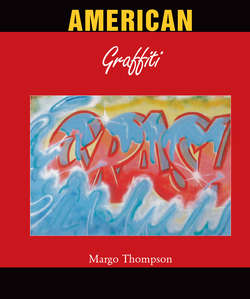Читать книгу American Graffiti - Margo Thompson - Страница 19
На сайте Литреса книга снята с продажи.
Subway Writers
ZEPHYR
ОглавлениеZEPHYR, from Manhattan’s Upper West Side, began writing seriously in 1977 and associated with a group of writers in Central Park. At first, like most writers, he dedicated himself to producing quantities of tags but eventually he collaborated with other writers from whom he could learn style such as NOC 167, FUTURA 2000, and DONDI. A window-down piece from 1980 may show DONDI’s influence with the serifs and crossbars lined up neatly, drawing the eye through the piece to the dramatically-enlarged leg of the R at the end.
ZEPHYR painted regularly with DONDI on Sundays in the train yard near his home at the end of the 2 line in Brooklyn, and in 1980 they worked together on a whole car design of ZEPHYR’s, ‘Heroin Kills’. The third contributor to this piece was Charlie Ahearn, a filmmaker based in Times Square who was in pre-production on a film about writing, rap, and break-dancing that would be released as Wild Style in 1982. Ahearn asked to come along on one of ZEPHYR and DONDI’s forays as part of his research for the film, but ZEPHYR was reluctant to take the risk and responsibility of having a ‘civilian’ with them. DONDI was inclined to let Ahearn accompany them, perhaps because he had already been trailed by photographer Martha Cooper when he painted his ‘Children of the Grave, Part Three’ train in May. Unexpectedly, Ahearn brought paints and an idea for his own piece.[92]
ZEPHYR had made few political pieces, preferring to perfect his tag. This piece was inspired by a friend’s attempt to kick his drug habit. He planned to paint ‘HEROIN’ with the I rendered as a syringe, while DONDI worked on ‘KILLS’. The lettering and palette of each word were slightly different, but compatible, and the break between the words was precisely where the centre doors opened. To the right was a notation that this piece had been produced as a ‘public service’. To the left was a red cartoon devil, not part of ZEPHYR’s original design, poking at ‘HEROIN’ with his pitchfork. This was Ahearn’s contribution. It was the ‘Hot Stuff’ devil from Harvey comics, which also featured Richie Rich and were intended for a juvenile audience. Ahearn’s appreciation for these characters was symptomatic of the taste for kitsch cultivated by some of the downtown artists with whom he associated, while writers like ZEPHYR and DONDI preferred comics for an older or countercultural audience, such as those by Vaughn Bodé or R. Crumb. Nevertheless, Ahearn’s devil worked well with the concept and design of ‘Heroin Kills’ and ZEPHYR considered his execution to be impressive, especially since Ahearn had no prior experience spray-painting trains.[93]
92
Interview with ZEPHYR, 4 November 2006.
93
Interview with ZEPHYR, 4 November 2006.
